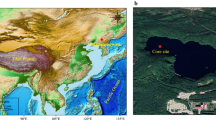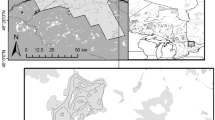Abstract
Relatively little is known about past cold-season temperature variability in high-Alpine regions because of a lack of natural cold-season temperature proxies as well as under-representation of high-altitude sites in meteorological, early-instrumental and documentary data sources. Recent studies have shown that chrysophyte stomatocysts, or simply cysts (sub-fossil algal remains of Chrysophyceae and Synurophyceae), are among the very few natural proxies that can be used to reconstruct cold-season temperatures. This study presents a quantitative, high-resolution (5-year), cold-season (Oct–May) temperature reconstruction based on sub-fossil chrysophyte stomatocysts in the annually laminated (varved) sediments of high-Alpine Lake Silvaplana, SE Switzerland (1,789 m a.s.l.), since AD 1500. We first explore the method used to translate an ecologically meaningful variable based on a biological proxy into a simple climate variable. A transfer function was applied to reconstruct the ‘date of spring mixing’ from cyst assemblages. Next, statistical regression models were tested to convert the reconstructed ‘dates of spring mixing’ into cold-season surface air temperatures with associated errors. The strengths and weaknesses of this approach are thoroughly tested. One much-debated, basic assumption for reconstructions (‘stationarity’), which states that only the environmental variable of interest has influenced cyst assemblages and the influence of confounding variables is negligible over time, is addressed in detail. Our inferences show that past cold-season air-temperature fluctuations were substantial and larger than those of other temperature reconstructions for Europe and the Alpine region. Interestingly, in this study, recent cold-season temperatures only just exceed those of previous, multi-decadal warm phases since AD 1500. These findings highlight the importance of local studies to assess natural climate variability at high altitudes.





Similar content being viewed by others
References
Auer I, Böhm R, Jurkovic A et al (2007) HISTALP – Historical instrumental climatological surface time series of the greater Alpine region 1760-2003. Int J Climatol 27:17–46
Battarbee RW (1986) Diatom analysis. In: Berglund BE (ed) Handbook of holocene palaeoecology and palaeohydrology. Wiley, Chichester, pp 527–570
Battarbee RW, Kneen M (1982) The use of electronically counted microspheres in absolute diatom analysis. Limnol Oceanogr 27:184–188
Baumann E, de Jong R, Kamenik C (2010) A description of sedimentary chrysophyte stomatocysts from high-Alpine Lake Silvaplana (Switzerland). Nova Hedwig Beih 136:71–86
Begert M, Schlegel T, Kirchofer W (2005) Homogeneous temperature and precipitation series of Switzerland from 1864 to 2000. Int J Climatol 25:65–80
Beniston M (2005) Warm winter spells in the Swiss Alps: Strong heat waves in a cold season? A study focusing on climate observations at the Saentis high mountain site. Geophys Res Lett 32:L01812. doi:10.1029/2004GL021478
Beniston M, Diaz HF, Bradley RS (1997) Climatic change at high elevation sites: an overview. Clim Change 36:233–251
Bigler C, von Gunten L, Lotter AF, Hausmann S, Blass A, Ohlendorf C, Sturm M (2007) Quantifying human induced eutrophication in Swiss mountain lakes since AD 1800 using diatoms. Holocene 17:1141–1154
Blass A, Bigler C, Grosjean M, Sturm M (2007a) Decadal-scale autumn temperature reconstruction back to AD 1580 inferred from the varved sediments of Lake Silvaplana (southeastern Swiss Alps). Quat Res 68:184–195
Blass A, Grosjean M, Troxler A, Sturm M (2007b) How stable are 20th Century calibration models? A high resolution summer temperature reconstruction for the eastern Swiss Alps back to A.D. 1580 derived from proglacial varved sediments. Holocene 17:51–63
Brockwell PJ, Davis RA (2003) Introduction to time series analysis and forecasting, 2nd edn. Springer, New York
Burman P, Chow E, Nolan D (1994) A cross-validatory method for dependent data. Biometrika 81:351–358
Casty C, Wanner H, Luterbacher J, Esper J, Böhm R (2005) Temperature and precipitation variability in the European Alps since 1500. Int J Climatol 25:1855–1880. doi:10.1002/joc.1216
de Jong R, Kamenik C (2011) Validation of a chrysophyte stomatocyst-based cold season climate reconstruction from high-Alpine Lake Silvaplana, Switzerland. J Quat Sci 26:268–275. doi:10.1002/jqs.1451
Diaz HF, Grosjean M, Graumlich L (2003) Climate variability and change in high elevation regions: past, present and future. Clim Change 59:1–4
Fox J, Weisberg HS (2010) An R companion to applied regression. Sage Publications, Inc., Thousand Oaks
IPCC (2007) Summary for Policymakers. In: Solomon S, Qin D, Manning M, Chen Z, Marquis M, Averyt KB, Tignor M, Miller HL (eds) Climate Change 2007: The Physical Science Basis. Contribution of Working Group I to the Fourth Assessment Report of the Intergovernmental Panel on Climate Change. Cambridge University Press, Cambridge
Jackson DA (1993) Stopping rules in principal components analysis: a comparison of heuristical and statistical approaches. Ecology 74:2204–2214
Juggins S (2009) Rioja: an R package for the analysis of quaternary science data. (http://www.staff.ncl.ac.uk/staff/stephen.juggins/)
Juggins S (2013) Quantitative reconstructions in palaeolimnology: new paradigm or sick science? Quaternary Sci Rev 64:20–32
Kamenik C (2010) Stom@ocysts & Co – web applications to bring the research community together via the Internet. Nova Hedwig Beih 136:311–323
Kamenik C, Schmidt R (2005) Chrysophyte resting stages: a tool for reconstructing winter/spring climate from Alpine lake sediments. Boreas 34:477–489
Kamenik C, Baumann E, de Jong R, Grosjean M (2010) Effects of cold season climate changes versus anthropogenic nutrient inputs on chrysophyte stomatocyst assemblages (AD 1940–2004) in annually laminated sediments of high-Alpine Lake Silvaplana (Switzerland). Nova Hedwig Beih 136:103–115
Kirchner M, Faus-Kessler T, Jakobi G, Leuchner M, Ries L, Scheele H-E, Suppan P (2013) Altitudinal temperature lapse rates in an Alpine valley: trends and the influence of season and weather patterns. Int J Climatol 33:539–555
Koinig KA, Kamenik C, Schmidt R, Agustí-Panareda A, Appleby P, Lami A, Prazakova M, Rose N, Schnell ØA, Tessadril R, Thompson R, Psenner R (2002) Environmental changes in an alpine lake (Gossenköllesee, Austria) over the last two centuries: the influence of air temperature on biological parameters. J Paleolimnol 28:147–160
Larocque-Tobler I, Grosjean M, Heiri O, Trachsel M, Kamenik C (2010) Thousand years of climate change reconstructed from chironomid subfossils preserved in varved lake Silvaplana, Engadine, Switzerland. Quat Sci Rev 29:1940–1949
Livingstone DM (1997) Break-up dates of Alpine lakes as proxy data for local and regional mean surface air temperature. Clim Change 37:407–439
Luterbacher J, Dietrich D, Xoplaki E, Grosjean M, Wanner H (2004) European seasonal and annual temperature variability, trends, and extremes Since 1500. Science 303:1499–1503. doi:10.1126/science.1093877
Mangini A, Spötl C, Verdesa P (2005) Reconstruction of temperature in the Central Alps during the past 2000 yr from a δ18O stalagmite record. Earth Planet Sci Lett 235:741–751
Mazerolle MJ (2011) AICcmodavg: Model selection and multimodel inference based on (Q)AIC(c). http://cran.r-project.org/package=AICcmodavg
Nussbaumer SU, Zumbühl HJ, Steiner D (2007) Fluctuations of the Mer de Glace (Mont Blanc area, France) AD 1500–2050: an interdisciplinary approach using new historical data and neural network simulations. Zeitschrift für Gletscherkunde und Glazialgeologi 40:1–183
Nussbaumer SU, Steinhilber F, Trachsel M, Breitenmoser P, Beer J, Blass A, Grosjean M, Hafner A, Holzhauser H, Wanner H, Zumbühl HJ (2011) Alpine climate during the Holocene: a comparison between records of glaciers, lake sediments and solar activity. J Quat Sci 26:703–713. doi:10.1002/jqs.1495
Oksanen J, Blanchet FG, Kindt R, Legendre P, O’Hara RB, Simpson G, Solymos P, Henry M, Stevens HH, Wagner H (2011) vegan: Community Ecology Package. http://CRAN.R-project.org
Pfister C (1993) Historical Weather Indices from Switzerland. IGBP PAGES/World Data Center-A for Paleoclimatology Data Contribution Series # 93-027. NOAA/NGDC Paleoclimatology Program, Boulder CO, USA
Pinheiro J, Bates D, DebRoy S, Sarkar D, R Core team (2011) nlme: Linear and Nonlinear Mixed Effects Models, http://www.r-project.org
Pla S, Catalan J (2005) Chrysophyte cysts from lake sediments reveal the submillennial winter/spring climate variability in the northwestern Mediterranean region throughout the Holocene. Clim Dyn 24:263–278
Pla S, Catalan J (2011) Deciphering chrysophyte responses to climate seasonality. J Paleolimnol 46:139–150. doi:10.1007/s10933-011-9529-6
R Development Core Team (2011) R: a language and environment for statistical computing. Austria, Vienna
Renberg I (1990) A procedure for preparing large sets of diatom slides from sediment cores. J Paleolimnol 4:87–90
Riedwyl N, Küttel M, Luterbacher J, Wanner H (2009) Comparison of climate field reconstruction techniques: application to Europe. Clim Dyn 32:381–395. doi:10.1007/s00382-008-0395-5
Sigl M (2009) Ice core based reconstruction of past climate conditions from Colle Gnifetti, Swiss Alps, Ph.D. thesis, Paul Scherrer Institute, Univ. of Bern, Switzerland
Simpson GL, Oksanen J (2009) Analogue: analogue matching and modern analogue technique transfer function models. http://cran.r-project.org
Smol JP (1985) The ratio of diatom frustules to chrysophycean statospores: a useful paleolimnological index. Hydrobiologia 123:199–208
Trachsel M, Eggenberger U, Grosjean M, Blass A, Sturm M (2008) Mineralogy-based quantitative precipitation and temperature reconstructions from annually laminated lake sediments (Swiss Alps) since AD 1580. Geophys Res Lett 35:L13707. doi:10.1029/2008GL034121
Trachsel M, Grosjean M, Larocque-Tobler I, Schwikowski M, Blass A, Sturm M (2010) Quantitative summer temperature reconstruction derived from a combined biogenic Si and chironomid record from varved sediments of Lake Silvaplana (south-eastern Swiss Alps) back to AD 1177. Quat Sci Rev 29:2719–2730. doi:10.1016/j.quascirev.2010.06.026
Trachsel M, Kamenik C, Grosjean M, McCarroll D, Moberg A, Brázdil R, Büntgen U, Dobrovolný P, Esper J, Frank DC, Friedrich M, Glaser R, Larocque-Tobler I, Nicolussi K, Riemann D (2012) Multi-archive summer temperature reconstruction for the European Alps, AD 1053-1996. Quat Sci Rev 46:66–79
van der Knaap WO, Lamentowicz M, van Leeuwen JF, Hangartner S, Leuenberger M, Mauquoy D, Goslar T, Mitchell EA, Lamentowicz L, Kamenik C (2011) A multiproxy, high-resolution record of peatland development and its drivers during the last millennium from the subalpine Swiss Alps. Quat Sci Rev 30:3467–3480
Venables WN, Ripley BD (2002) Modern applied statistics with S, 4th edn. Springer, New York
Von Gunten L, Grosjean M, Kamenik C, Fujak M (2012) Urrutia R (2012) Calibrating biogeochemical and physical climate proxies from non-varved lake sediments with meteorological data: methods and case studies. J Paleolimnol 47:583–600. doi:10.1007/s10933-012-9582-9
Xoplaki E, Luterbacher J, Paeth H, Dietrich D, Steiner N, Grosjean M, Wanner H (2005) European spring and autumn temperature variability and change of extremes over the last half millennium. Geophys Res Lett 32:L15713. doi:10.1029/2005GL023424
Zorita E, Moberg A, Leijonhufvud L, Wilson R, Brázdil R, Dobrovolný P, Luterbacher J, Böhm R, Pfister C, Riemann D, Glaser R, Söderberg J, González-Rouco F (2010) European temperature records of the past five centuries based on documentary/instrumental information compared to climate simulations. Clim Change 101:143–168. doi:10.1007/s10584-010-9824-7
Zumbühl HJ, Messerli B, Pfister C (1983) Die Kleine Eiszeit: Gletschergeschichte im Spiegel der Kunst. Katalog zur Sonderausstellung des Schweizerischen Alpinen Museums Bern und des Gletschergarten-Museums Luzern vom 09.06.–14.08.1983 (Luzern), 24.08.–16.10, Bern
Acknowledgments
We thank D. Fischer, E. Baumann, P. Dessarzin and S. Hagnauer for laboratory assistance. Two anonymous reviewers provided helpful comments and suggestions that substantially improved the paper. Discussions on statistical testing and assumptions with M. Trachsel and R. Telford were highly appreciated. Project funding was provided by an EU IEF Marie Curie Grant (PIEF-GA-2008-220189) to R. de Jong. This project is part of the EU FP 6 project Millennium (EU FP6 IP SUSTDEV-2004-3.1.4.1 Contract: 017008).
Author information
Authors and Affiliations
Corresponding author
Rights and permissions
About this article
Cite this article
de Jong, R., Kamenik, C., Westover, K. et al. A chrysophyte stomatocyst-based reconstruction of cold-season air temperature from Alpine Lake Silvaplana (AD 1500–2003); methods and concepts for quantitative inferences. J Paleolimnol 50, 519–533 (2013). https://doi.org/10.1007/s10933-013-9743-5
Received:
Accepted:
Published:
Issue Date:
DOI: https://doi.org/10.1007/s10933-013-9743-5




